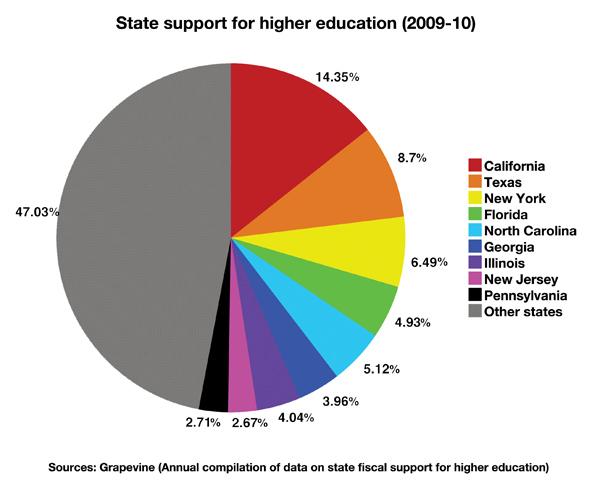Higher education no longer a ?public good,? experts say

Megan Harris:Source: Grapevine (Annual compilation of data on fiscal state support for higher education):Megan Harris – State Hornet
September 22, 2010
Some political scientists believe that higher education is “eroding from all sides.”
According to a recent Chronicle of Higher Education article, professors and political scientists speaking at the annual American Political Science Association meeting agreed that higher education is no longer considered a “public good.”
Associated Students Inc. President Terry Martin agrees that in the most technical economic sense, at least in California, higher education really is not a public good.
“A public good is non-rivaled and non-excludable,” Martin said.
He said that a park, for example, is considered a public good because it will always be available for the public to use regardless of how many people were already there.
He said what stops higher education from being a public good in California is the reduced state support caused by the damaged economy.
For example, Sacramento State’s enrollment shrank by 3,000 students this year.
Middle class parents will barely be able to scrape together the funds to pay for their children’s education, and those with less money will eventually see public universities as a luxury only suited for America’s richest families, Clyde W. Barrow, director of the Center for Policy Analysis at the University of Massachusetts at Dartmouth, said in the article.
“It’s a no-brainer,” said Lois Boulgarides, interim president of the Capitol Chapter of California Faculty Association. “We’re not adequately funded atall. There’s just no question.”
However, in a Legislative Analyst’s Office report released in July, California is ranked as the No. 1 state based on the amount of funding it used in the 2009-10 fiscal year to support higher education, which is more than $11 billion. The report also showed that California’s student fees for universities and colleges are 20 and 69 percent below the national average, respectively.
The report’s data was based on Illinois State University’s Grapevine, an annual survey that determines each state’s fiscal support of higher education.
“What the survey also did was compare the states’ budgets with their population,” said Steve Boilard, director of higher education for the Legislative Analyst’s Office.
Despite being the state with the most higher education spending, California is ranked No. 11 on its support per capita, which is the amount spent in proportion to the population.
“Sure, California spends the most on funding colleges and universities, but it’s not as important a statistic compared to our spending per capita,” Boilard said.
He said California’s spending should be especially high because the state’s numbers of students and professors are among the highest in the nation.
Boulgarides said it is artificial to compare California with other states because states have different needs.
Fewer than 40,000 students were admitted to the California State University this year because of all the budget cuts, Boulgarides said. She said for people in low-income backgrounds, education can be a crucial means to move up in the world.
“A high percentage of those folks really depended on the system because they were low or middle class,” Boulgarides said.
Cary Nelson, president of the American Association of University Professors and professor of English at the University of Illinois at Urbana-Champaign, said in the Chronicle of Higher Education article in addition to schools’ inadequate funding, spending its money on multimillion-dollar projects is also in the wrong.
He also said that activists should fight for a tuition-free public higher education system that is fully financed by the government.
“Having resources and spending them wisely go hand-in-hand,” Boulgarides said. “They’re equally important, and our administrators need to prioritize academics because that’s what the purpose of school is.”
Boulgarides said students and faculty, and the campus administration have different priorities.
“I think if you asked a student, they would rather have more classes,” she said. “There is no building that will substitute for a relationship between a student and a teacher.”
However, Provost and Vice President of Academic Affairs Joseph Sheley, said Sac State has been effectively spending the limited resources it has.
“Sac State values everything equally that would make it a good university,” Sheley said.
He said a vast majority of the school’s funds are strictly for the students and for their education.
If one considers the historical context, California has been and remains a fairly high supporter of higher education, and its social commitment to a strong economy and workforce has always been there, Sheley said.
Boulgarides said California needs leaders who value higher education and are willing to fight for the underrepresented college applicants. She said the idea of a tuition-free education for college students is not reasonable given our economy’s condition. But substantially decreasing the prices of colleges and universities is doable – and should be done.
“If you make the investment, you’ll have productive members of the society and state,” she said.
Micah Stevenson can be reached at [email protected].















































































































































